“Hi Al,
I imagine several people have problems (especially in N Scale) getting longer trains on the track. The worst for me is a 10 car TGV that simply refuses to keep the wheels I’ve already managed to get right on the track whilst I sort out the rest.
I’ve found a solution. In my favourite train shop in Zurich (Züri-Tech) there is an extensive second-hand/pre-owned section and I found a few pieces of Trix part number 4974 (see picture A) for 1 Swiss Franc each (about 75p).
As you can see they taper down from a thickness of about 4mm in the centre to 1mm at the edges. Their real use is as re-railers but my problem was getting the train on the track to start off with.
It occurred to me that with a bit of modification (see picture B) I could put one of these at the end of a siding. Then, once the power car was on the track, I’d let it haul the rest of the rake on.
It works! As the engine draws forward (you have to keep the speed down, and it helps if you line things up as well as possible) the remaining coaches and trailing car are guided onto the rails. Now, after months of cursing I can get the TGV, Thalys, ICE, Ave, and just about anything else on the rails in seconds.
Best regards,
Paul”
Wow – that’s smart! A big thanks to Paul.
And now on to Barry:
“Al,
Here’s my story about the basement train layout – Barry Palmer (age 62).
This layout is in HO scale. I purchased these trains and supplies almost (20) years ago. I had just started building a layout back then but then went through a divorce and since then have never had enough room to build another layout.
My Grandson Porter is almost (6) years old and is absolutely fascinated with trains. I asked him a year ago if he would like my train and help me build a layout in his parents’ basement for his Xmas and birthday present and he didn’t even hesitate with his answer.
My daughter Nikki (Porter’s mother) has also taken an interest in the building of this layout which we started in mid January and just completed it last week.
I mentioned before that they live 1-1/2 hours from me so I would travel to their house and stay 2-3 days maybe twice a month to work on it.
The total hours spent on it were approximately (140). I’m retired but have both a (30) year engineering and an (11) year General contractor (construction) background so I am quite detail oriented and have all the required to do this kind of project.
I designed the entire layout and track plan based on the buildings that I had from my collection over the years. I made the trackplan basically an upper and a lower loop with a couple of sidings and spurs with mechanical turnouts and analog controls to keep it simple as he’s only almost (6) and mainly enjoys the trains travelling around their respective loops. I put an MRC sound system on it so he can make the appropriate sounds to add realism.
The layout is designed with the ability to add at right angle to the farm end another 4 x 8 portion that would include a double helix to get from one level to the other. The outside will have stained door casing at the top edge and black or gray curtains to the floor to hide the under part and make it look like a piece of furniture. The street light are functional but we haven’t installed the interior building lights yet.
Many of the items are scratch/scrap built. The gas station canopy and gas pumps I created from all scraps.
The asphalt road and sidewalks are made from residential roofing products with the sidewalks painted gray and the road lines are yellow and white tape cut down to strips approximately .040 wide.
The signage my daughter made on the computer.
The chainlink fencing is created from window/door screen cut on the diagonal and I use air gun nails from my construction tools for the posts.
Most of the trees are made from real tree branches with Woodland Scenics’ clump foliage applied.
Most of the mountains and there’s a lot of them are made with cheese cloth from a crafts store and boxes of Plaster of Paris to keep the budget down in-lieu-of plaster cloth.
Once again, I thank you for all your interest and publishing our various stages of development. My Grandson, when he gets older will have theknowledge that his train layout was published and seen by modelers all over the globe.
Regards,
Barry”
See the finished version here.
That’s all for today folks.
Please do keep ’em coming.
And don’t forget the Beginner’s Guide if you want to stop dreaming and start doing.
Best
Al
Click here for the latest ‘ebay cheat sheet‘. You’ll be glad you looked…


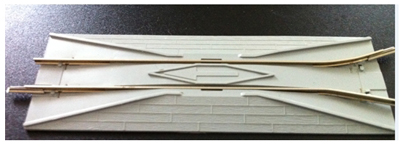
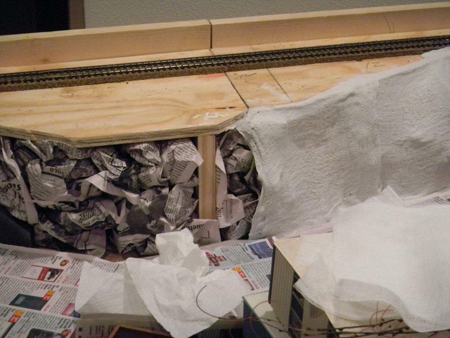
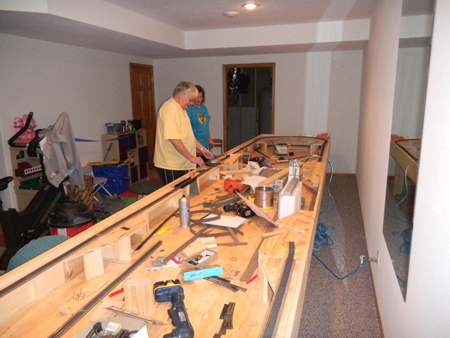
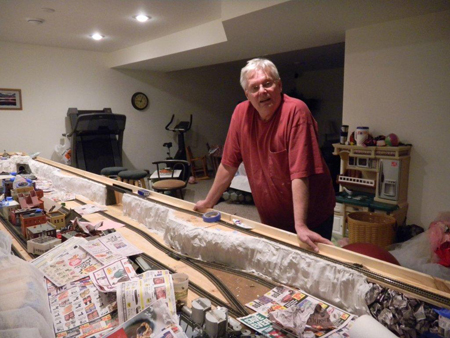
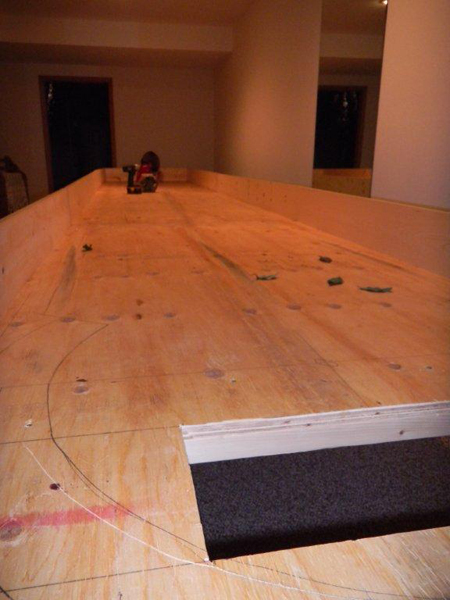
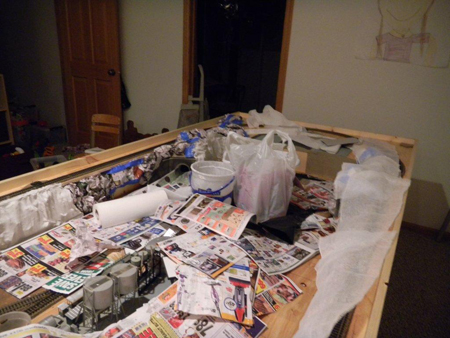
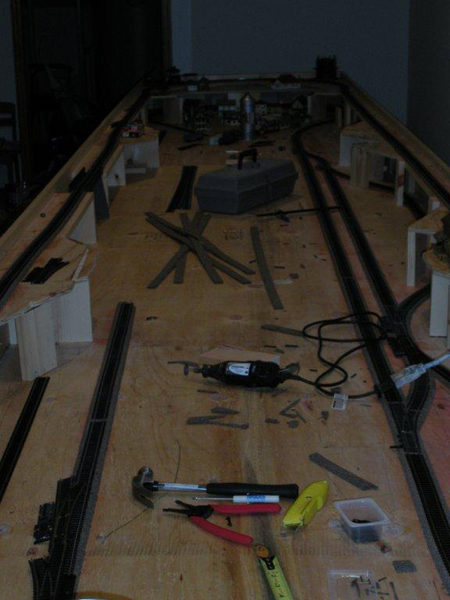
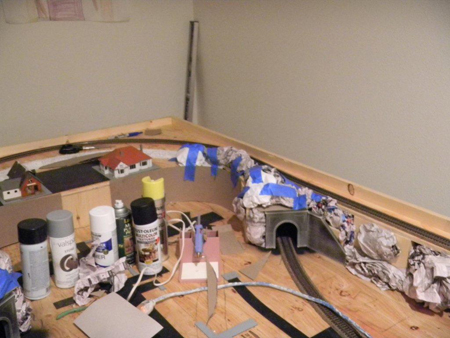
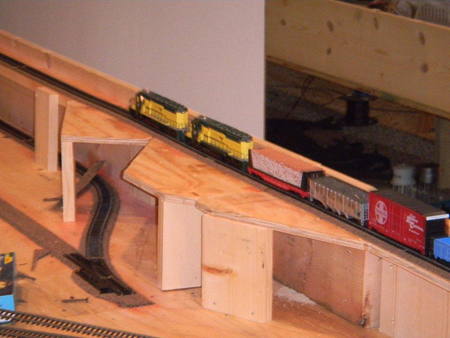
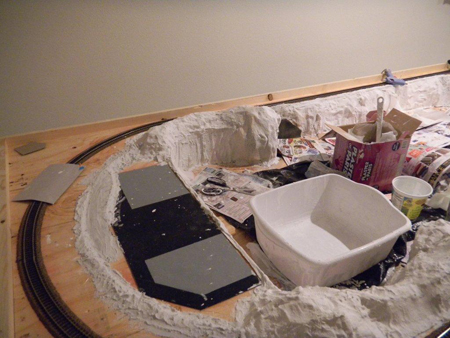
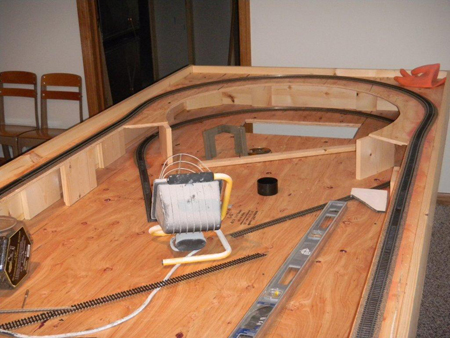


Hornby do one like this, it is an un-coupling track but it also acts as a railer/re-railer. No. R620
I like the auto rail loader,looks makable and very commercial,I want !!! keep up the good work. Roy
Ingenious! I’ll remember this one. Well done.
can you buy a rerailer in ho, I need to do this trick as when old eyes wear glasses it is hard to place stock on the line.
we have one of these in the first set I purchased for my son about three years ago. It’s more help with him as at 6yrs old he lacks the manual dexterity and patience to correctly align the wheels on the rail. We have HO layout
I have found that by running each car back and forth by hand across a rerailer track such as the one shown it aligns the wheels with the track quite well. I then roll the car toward the engine and continue with the next car, works like a charm!
Hi Al,
Just have to make one of those; what a great idea!
I believe LIMA made, I actually have one, a rail-crossing which can be employed in the same fashion as the trick suggested by Randy Smith.
You can make them fairly easily with plastic (shirt-collar offcuts or something similar) to guide the wheels from the inside and inclines to let the flanges climb over the rails from the outside. Doesn’t work well on curved track. Put them permanently in hidden spaces (tunnels and fiddle yards) and Murphy’s law comes into play – magically the stock stops de-railing altogether.
I have been mnaking them out of Balsa wood about 2 in. long works very well on N gauge.
It sounds to me like most of you have missed what he was doing. You are just using a rerailer which is nice of course, but look again at his picture A and B, on the right side of B the rails are spread to catch the truck and make it turn to align with the rail and rerailing plastic. this is not a regular rerailer, do not try to go the opposite direction. We use this same idea in Live Steam at the loading/unloading turntables to align the cars to the track from the transporting vehicle. Save a lot of lifting in the hernia gauges.
If you look at the picture of either the normal rerailer or the modified one, you will notice an arrow in the center to designate the direction that rolling stock needs to travel through the device. Spreading the rails on the inbound end seems to me to be a quite clever solution to getting stock onto the rails properly from the beginning.
Peco have been making stock railers for many years. SL 37 for HO/OO and SL337 for N scale stock. You sit the railer on a straight piece of track and put your chosen item on the railer with the wheels pointing in the general direction of the track, and the wedge shape built into the railer line the wheels correctly for the track. If it is a loco the bogies line up with no hassle, you just push the loco onto the track. If it is rolling stock then the ramp shape of the railer allows the rolling stock to roll down under its’ own weight onto the track. The railers are long enough to hold a tender loco or a coach. Hassle free loading of stock onto the rails.
Once I get all my trains on and going, whats the best way to PREVENT them from derailing? My grandson and I hate it when they come off track.
Most of the problem(s) with cars derailing, especially with longer trains, usually occurs with cars that have truck mounted couplers. These are usually found with “train set” cars. Your better quality cars will have body mounted couplers so as your train pulls, you are pulling from the car body and NOT the truck assy. Pulling from the truck assy. tends to want to straighten the trucks and causes the derailing. There are after market couplers (several on the market now) that can be used to retro fit truck mounted couplers. I hope this helps!
Paul& Al
This looks like a very good idea .I am going to try it on a ho train track. Keep up the good ideas
John .C.
I change all my cars to body mounted couplers . { K D } and that has stopped 90-95 % of my derailmants . I also check the guage of the wheels with the HO track and wheel guage and what a difference it makes to be able to run the railroad with out the derail problems .
I had this problem until I put a re-railer piece in the area of the derailing. Thank to it being in the far area where it doesn’t show. Also I have put metal wheels on the cars that came without them.
I wouldn’t bend the rails of your rerailer track like that if I were you – looks to me like you might get some of the wheelsets trying to wedge themselves in the gap, which could push the wheels in on the axles. If the gap between the backs of the wheels is even a smidge too tight, you will find they tend to derail on the blades or checkrails of pointwork. Other common causes of derailments I’ve noticed are (a) tension lock couplers where the hooks have gone the wrong side of each other and so are putting sideways force on each other in curves, and (b) where a rail of flexitrack has slid along slightly through the chairs, opening up a gap at a fishplate.
Rod
Looks like a winner to me! As long as the leading wheels begin to ramp up before squeeze takes place there shouldn’t be any change take place.
Don’t have trouble keeping long trains on track. At My club The West Sussex N group we have some very long trains including the Bullet trains and Eurostar. at a show we had a Farish 33 powered with a Minitrix chassis. It is known as the manic one as it takes anything dumped behind her. On YouTube the is a 45 sec video of it hauling 60 Minitrix coaches (Trix class 33 pulling 60 coaches). Often we have freight trains with 100 10 ft. wagons and no trouble. Failure can only be attributed to bad maintenance of track or stock. Dirty wheels don’t help.
Chris.
really don’t have to make any modifications…Just add a few re-railers here and there on your layout and you can do the same thing by running the engines and any cars thru the re-railer and there you go. Why make it difficult?
I have sculpted a rerailer in hidden sections of my railroad using common patching plaster. Just put a three inch patch of wet plaster on the rails and use a small stick to make the required ramps.
I seem to be having an issue keeping everything on the rails going through turnouts.
I’m using Atlas and a Bachman turnout.
Is there any source of an HOm rerailer?
Surprised nobody mentioned Kato railer as supplied in most Japanese train sets, fits astride the rails for initially putting trains on, most Shinkansen are 16 cars long.
Works very well, kato also do a track retailer.
Martin
Hi Everyone
I’m new to model railroading and one of my problems
I can’t figure out is that at times my turn outs seem to catch
the trucks on the engines or other rolling stock and want to make them take the side track. My other problem seems
to be that my turn outs seem to pinch the trucks at times.
It is so intermittent that I can’t figure it out.
Any suggestion or posible solutions?
Really nifty. Like all the best ideas, it’s simple and cheap.
NEIL
A solution to keeping your trucks from catching on the turnouts is to file the points on your turnout flat against the stock rail of the turnout. I think it’s the wheels that’s catching the points of your turnout, not the trucks. Check it out. Rocco.
Most american if not all track manufactors make re-railer tracks.
Atlas makes a longer rerailer “#518” and I put at least one on every layout that I build. It’s nice to have for the layout that is uner the Christmas Tree.
I may totally stupid but I can’t see how picture B could work. I have several re-railers throughout my layout.. I also replaced the plastic wheels with metal which also helps.
Hey,
Is NOT a re-railer, the “re-railers” as some have pinted out are great for pushing the trucks back onto the tracks. The is a “RAILER” WHAT? Puting the “railer” on at the end of a siding, can put a group of cars together on the flat surface, NOT the tracks, then SLOWLY pul the train forward up ON TO the tracks. By bending the ends out, acts as a funnel and gets the trucks between and onto the track ready to roll. No fidiling around with trying to get wheels lined up between the tracks. Gets harder with the smaler scales and older eyes. Or as one post commented, the less steady hands and in paitence of youth
I bought a Kato retailer on eBay for under $3. Snaps on the track and the cars roll down by themselves. The grandkids love to use it (as do I). It’s easy and reliable.
you can buy ramps in all scales that just sit on top of track & is not permanent , which does the same thing , i have one in N-scale it only cost a few bucks, this makes it nice if you run your trains on other tracks that aren’t yours like if your in a club , you can get them from most hobby shops
I live in Arizona does anyone know where I can buy Owens Corning 2 inch extruded foam boards???? Home Depot or Lowes does not carry them. Some carry 1 inch blue Dow. I really would like the 2 inch or more. Thanks any help will be great. Tom Payson AZ.
I found a source in Tucson. Please reply if interested and I will look it up.
When I bought my 2-6-6-2 steam engine, it came with a railer. Lay it on a straight stretch, roll a car down it, it is on the track, no problem. It is almost a required item for engines with leading and trailing trucks.
Where on a layout is the worst place for a derail? In a tunnel, of course. I have a rerailer as part of the track in my tunnel, just in case.
Still in training,
Carl in Kansas
Neat idea, why didn’t the manufacturers think of it? It just goes to show that we don’t know it all, haven’t learned it all and while Paul may be a rocket scientist or a carpenter we can all learn something from one another, Thanks for sharing this. I have some friends to share your idea with?
I work at Chi-Town Union Station where we routinely run 400 car coal trains and once ran a train with 1206 cars in O-scale. We keep that long train on the track by carefully weighting each car with pieces of wheel weight lead and a precision scale. I made a “railer” out of a stack of five business cars hich I carry in my shirt pocket because you never know where you will need it. our 400 computers run 30-40 long trains at a time and nothing is perfect.
Seth
I have been using this type of rerailer from both Baughman and Atlus .
, I don’t remember their part numbers but most of mine are over 15 years
old buy now and still work as intended with out bending the ends of the rails
as long as you go slow entering them and I have enough of them to place
in line with switches and in tunnels but it also helps to replace the all plastic wheel sets with all mettle axels and wheels and I have an alinement tool block made
of hard plastic that helps to set the wheels at the right gap for both N and Ho
gage rolling stock that is older than 25 years and I don’t remember the part number for it ?
I’m getting to old to remember the numbers any more because of some-timers !
George
In addition I do not start my inclines on the curves of my rails , I find I have less problems with derailing after going over my rolling stock every so often to make sure they are in gage and clean and like the book tells you -soldering the joints
in the rails helps as long as you clean the solder after you do the joint so as to
keep the joint free of obstructions . T hat is my way of having less problems with my tracks I hope this helps any and all that are having this problem !
George
I stretched a published post card size drawing to nearly 24 feet along one side of my garage for an N scale layout. Rerailers like the one shown in picture A were used to cross all joints between the eight foot long pieces of homasote covered plywood supporting the tracks. If I ever move it will be easy to take out the rerailers and reassemble them at the new location.
I pull 35 cars at a time with multiple engines. Treat your train like a real one. Put in a mid train engine and a pusher on the rear. Relieves drawbar pressure on the cars. Also keeps cars on the track in turns.
I am returning to enjoying model trains ( HO scale ) after a nearly 50 year break. I am having a problem that I don’t recall having in the past. My cars are constantly derailing and becoming a real frustration. I have several cars from years past and notice that they are much heavier than the newer, mostly lightweight plastic ones are. Is there a simple remedy to this ? Earlier in this stream there were helpful suggestions to change the wheels, change to body couplers (in place of truck mounted). Any other suggestions ? Also, I put up a train set, with village, around the Christmas tree this year. My steam locomotive wheels caught some of the cotton fibers and wrapped them tightly around the driving mechanisms. Any thoughts on getting this “stuff” out ?
Hi all, I have an extensive “S” Gauge American Flyer setup that has the same problem. I put a dozen re-railers in the system where derailing was occurring and that solved the problem. Only problem was finding re-railers for a train set that is over fifty years old. I managed to locate these on E-Bay but they are expensive, however now is all well. Best to all, Jon.
I had a friend years ago, he’s passed now, that made the most sense to me on pulling long trains around a layout. However, it was time consuming. But as model railroaders, thats what it’s all about, right? Now his layout was HO scale in his shop and he was able to pull over a hundred car train around a hairpin curve that had a slight declination where when the lead passed the tail it was about the train heighth lower. He had five powered units with the fastest in the lead cause you all know, you’re not gonna have even two powered units that pull the same speed. This allowed the units to spin and pull, not push, spin and pull. Now with the rolling stock. He configured a ramp that stratteled a straight section of level track track. The ramp was about a foot long and maybe 6 inches high. He would place the freight cars of various types one the ramp, one at a time marking how far they rolled and makig a log. After this task was completed. He would weight all the other cars so they all made it to the longest mark. In assembling the train on the track, all the short cars were placed behind the engines. With the last 25 cars being the longer cars with the last three or four being the 5 segmented trailer/train units with a single caboose on the end. All his engines and rolling stock were of the Athearn brand which have the couplers mounted on the body and not the trucks. It was quite an accomplishment and I do believe he had an article of this in Model Railroader magazine that would have been sometime in the year of 91 through 93. It was amazing watching this extremely long train come aroind the hairpin without pulling itself in to itself and derailing causing a major disaster on his layout. As for rerailers. Those can be purchased through Tyco, Bachman, Atlas, Athearn and others. They look like railroad crossings for autos and can be integrated into the layout or hidden in a tunnel. They make curved and straight ones.
About 25 years ago, Fleicshman put out a plastic rerailer. It is part no:9480. It is a long taper that you use to put the cars on.
Hello everyone from the US. This terrific idea. Atlas Model Railroading Co. makes rerailers in Ho and N scale that could also be adopted to this application.
I have solved the derailing problem by using several devices on my layout, even with inexpensive rolling stock. I enjoy buying cheap ($3.00 0r $4.00) used cars at
my local hobby shop…even Tyco and Mantua… Then I take them home and start the transformation. First, remove the shell from the frame. Then remove the trucks, remove the plastic wheels and replace them with Intermountain non-magnetic 33 inch metal wheels (I paint each one a brownish gray before installation) Now, place the shell the frame and the trucks with metal wheels on a postage scale. Add weights to the scale until you achieve the desired weight. (NMRA says one ounce plus 1/2 ounce per inch of the car) That would mean a 40 foot boxcar should weigh around four (4) ounces… I usually go an additional ounce on every car. I buy large washers (UAD) at Lowe’s by the box and stack them in the boxcar directly over the trucks…glue them together sandwich style with CA…Then I attack the couples…If the car has couples on the trucks I cut them off and file the plastic smooth…Then I glue a coupler box to the end of the car being careful to get it exactly centered… I buy Kadee 148 metal couplers and they come with a very nice coupler box arrangement. They also come in a long and short version as well as high and low version, which usually keeps you from using the small red washers under the trucks. I keep a piece of sample flex track mounted on a 1X3 on my workbench, with a rerailer and a Kadee coupler height measurement device…I double check the height of every coupler until it matches PERFECTLY…Then I weather the car, weather the trucks and put everything back together. The boxcar now has metal wheels, metal couplers at perfect height and weighs around 5 ounces…This car will stay on the track, believe me!
Nice job Paul, and yes, you can get a railer for any scale. I like to tinker with all kinds of things, and my 0 scale and HO scale is no deference. I am still thinking of what my table is going to look like, if it is a table at all.??? I have some ideas. But as usual I will keep on reading and looking at the pictures that everybody sends in and I will start putting mine together. Keep on keeping on rail folks. This is St.Petersburg S.D.G R&R Line.
Great idea Paul and nice pictures also.
I always discover that the “response” comments afford a wonderful experience into my fellow model railroader’s thoughts.
To the fellow with the material wrapped in his train wheels ~ unfortunately, the only solution is disassembly.
Good modification to rerailer. Before using rerailers etc., recheck wheel spacing on axles to make sure they have not moved in, or out, from proper spacing. John Sims Jeter – Huntsville, AL.
You really come up with some great ideas generated by past ideas.
i’ve got to tell you some of them were real doozies .this idea
sounds great to me because it’s the point i am at with my layout
i have acquired 6 diesel locomotives and now need freight rolling stock although i am s newbie to this hobby i jumped right in,although i only have the use of one arm. i’m constantly making jigs to make up for the loss of the left armand hand which means it takes me a little longer,sometimes frustrating.
I believe one way to prevent derailing on the light weight cars is to add a littl weight over the trucks to keep them down.
Here are my tips for keeping cars on the tracks.
1. Check wheel gauge with an NMRA gauge. This will do more than just this.
2. Car weighting, I go by the NMRA standard. I use the NAPA 1/4 ounce tire weights that are self sticking. I put the weight on each end as close to the end as possible. My theory is that weight between the couple and truck helps as this mass goes outside the curve to counter the force trying to pull the car over to the inside of the curve.
3. Insure that each axle is very free turning. Use a dry lube to lubricate. For plastic trucks use a device from Micro Mart to ream the inside of the truck to remove imperfections.
4. Check coupler height. Insure all are the same and double check the “glad hands” on Kadee couplers for correct height.
5.. If derailments happen at one spot check track gauge and for lumps, dips, twists, matter inside the rail, and joints.
Smooth operation is the sum of all. No one solution is a magic bullet for all problems.
I use these at road crossings and then the train is kept on the track every time it crosses.
I work with S Scale (American Flyer) I had to take my road crossing out of my track plan. Each time a train with nickel couplings passed over the road crossing plate, I would get an disconnect between cars. Link coupling passed over the crossing without any trouble. Any suggestions on salving this problem?
Derailments occur on full size railroads. It adds more realism on a model railroad. Keeping trackwork in tip top condition whether full size or scale is important.
Great tips ! I’m just getting back into HO railroading after 40+ years. How far apart is the minimum distance for parallel tracks?
I am just trying to get my railroad hobby back at age 74. Thank you so much for all the wonderful layouts and techniques. It’s been so long since I had a railroad running I forgot all kinds of important things. Keep it coming!